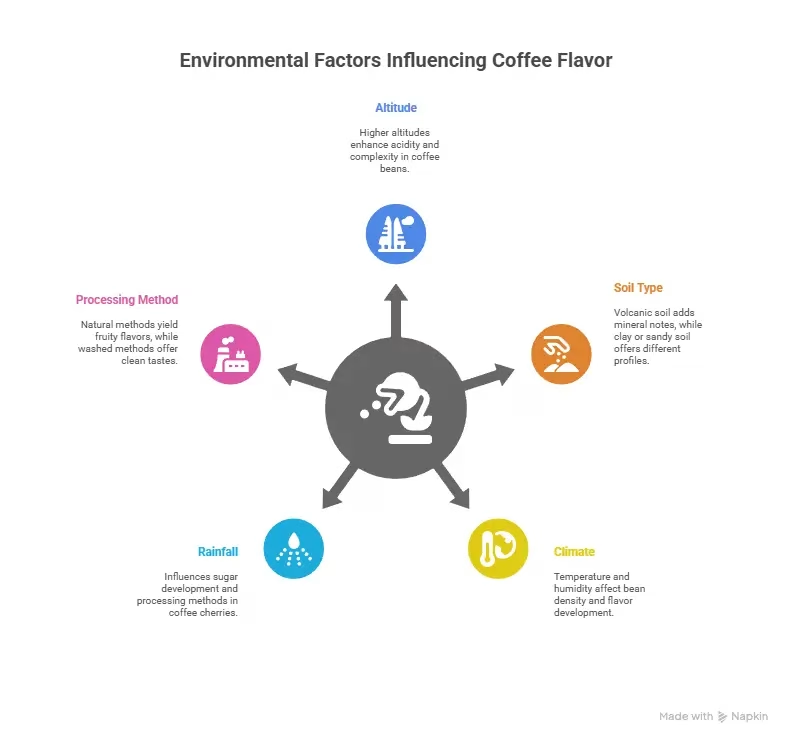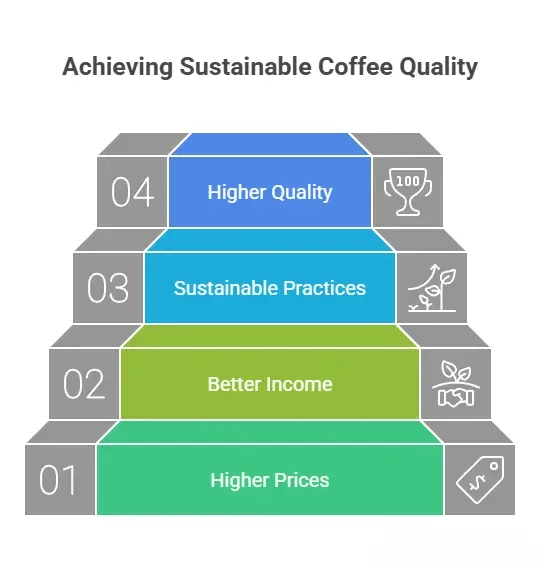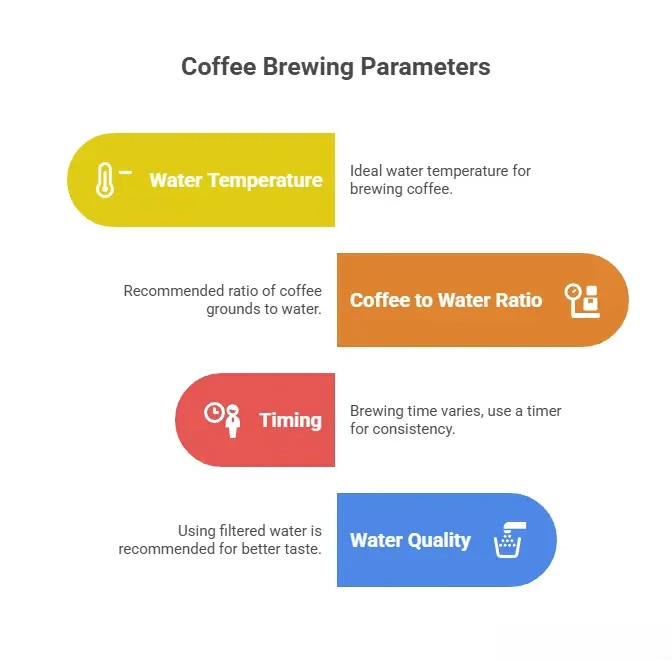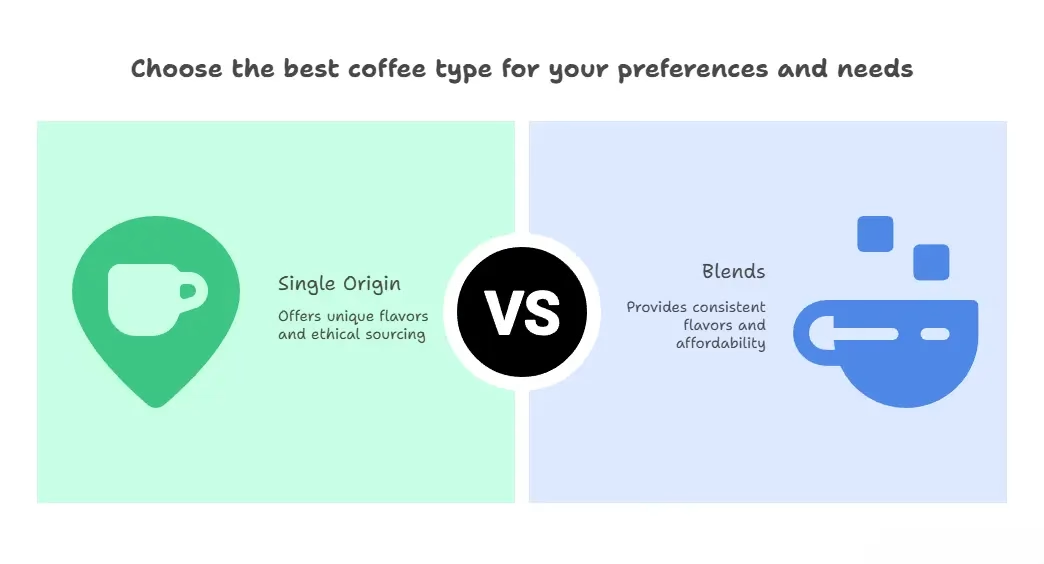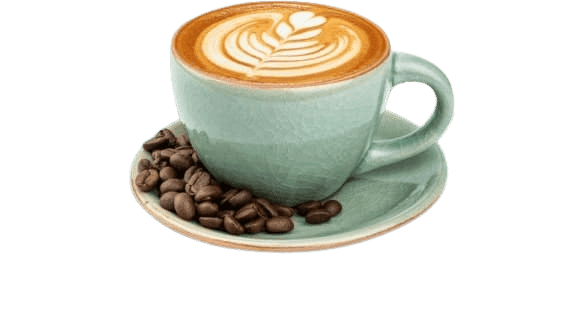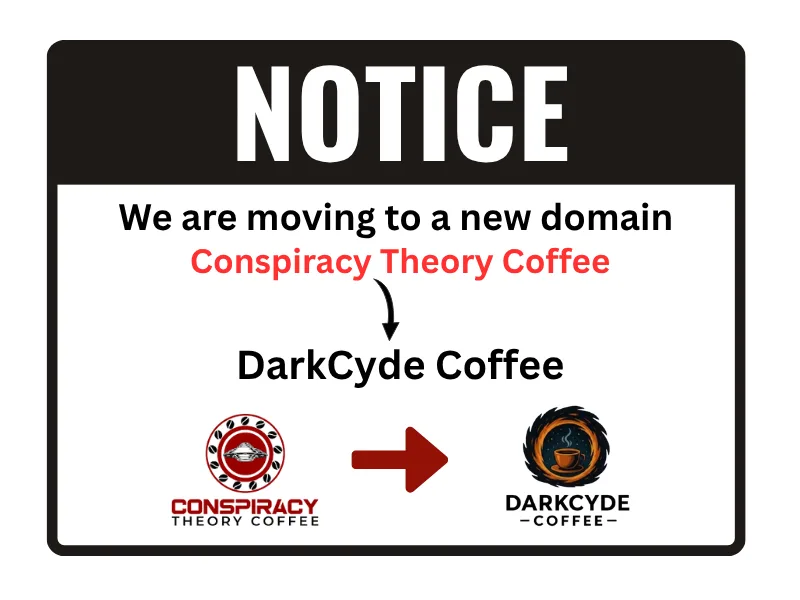Blog
Beginners Guide: What Is Single Origin Coffee?
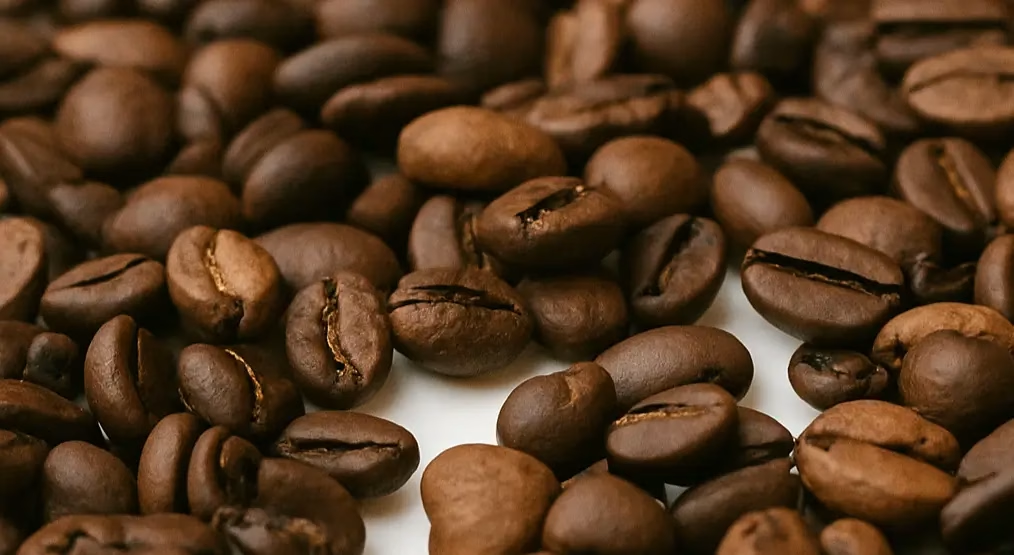
Imagine sipping a cup of coffee that tastes like blueberries and jasmine, with no artificial flavoring added. That distinct, almost magical taste? That’s the power of single origin coffee – where every sip tells the story of its birthplace.
Single origin coffee is coffee sourced from one specific geographic location – whether that’s a single farm, region, or country. Unlike blends that mix beans from multiple sources for consistency, single origin coffee celebrates the unique flavors that come from specific growing conditions, processing methods, and local expertise. This comprehensive guide explores what makes single origin coffee special, why coffee enthusiasts are willing to pay premium prices for it, and how you can experience these unique flavors at home.
📚 Table of Contents
- What is Single Origin Coffee?
- Real-World Flavor Examples
- Single Origin vs. Blends: The Key Differences
- Who Chooses What?
- Why People Pay More for Single Origin Coffee
- The Value Debate: What Coffee Drinkers Really Think
- How to Brew Single Origin Coffee for Best Results
- The Consistency Challenge
- Is Single Origin Coffee Right for You?
- Getting Started: Your Single Origin Journey
- The Bottom Line
What is Single Origin Coffee? The Essential Definition
The Core Concept
Single origin coffee is coffee grown within a single, traceable geographic origin. This isn’t just marketing speak – it’s a fundamental approach that prioritizes authenticity and traceability over consistency.
The specificity can vary dramatically:
- Country level: Ethiopian coffee
- Regional level: Colombian Huila
- Farm level: A specific estate or cooperative
- Micro-lot level: Beans from a particular section of a farm
- Varietal level: A single type of coffee plant
Why Location Matters: The Science of Terroir
Just like wine grapes, coffee beans are profoundly influenced by their environment – what the coffee world calls “terroir.” Here’s how different factors impact flavor:
| Environmental Factor | Impact on Flavor |
|---|---|
| Altitude | Higher altitudes create brighter acidity and more complex flavors |
| Soil Type | Volcanic soil adds different mineral notes than clay or sandy soil |
| Climate | Temperature and humidity affect bean density and flavor development |
| Processing Method | Natural (fruity) vs. Washed (clean) dramatically changes taste |
Want to geek out more on how this works? Know more about how terroir affects your coffee ->
Real-World Flavor Examples
Here’s what terroir actually tastes like in your cup:
| Origin | Signature Flavor Profile |
|---|---|
| Ethiopian Yirgacheffe | Blueberry, jasmine, honey – like drinking a fruit bouquet |
| Colombian Huila | Chocolate, citrus, caramel – balanced and crowd-pleasing |
| Sumatra | Earthy, herbal, full-bodied – think forest floor and cedar |
| Kenyan | Blackberry, citrus, bright acidity – wine-like complexity |
| Costa Rican | Users describe it as tasting like “Gushers fruit snacks” |
One coffee enthusiast described Tanzanian Peaberry as having distinct “pear and floral” notes, while Burundi coffee reminded them of “spice cake with cherry liqueur aroma.”
Single Origin vs. Blends: The Key Differences
Think of coffee blends like movies – you can watch them repeatedly and get the same experience every time. Single origin coffee is like live theater – each performance is unique, influenced by the specific conditions of that moment. Read more of our detailed comparisons between single origin vs blends.
| Aspect | Single Origin | Blends |
|---|---|---|
| Philosophy | Showcase unique, authentic flavors | Create consistent, balanced profiles |
| Availability | Seasonal and limited | Year-round consistency |
| Experience | Adventure and discovery | Comfort and reliability |
| Consumer Appeal | “Novelty, excitement, surprise” | “Routine, perfectly suited preferences” |
Who Chooses What?
Single Origin Enthusiasts tend to:
- View coffee as exploration and hobby
- Appreciate seasonal variation
- Enjoy detailed tasting notes
- Value transparency and ethics
- Are willing to pay premium prices
Single origin enthusiasts treat coffee as a journey of discovery, often keeping journals to track experiences and researching farms and processing methods. They embrace seasonal changes, understanding that their favorite Ethiopian coffee will taste different each harvest. These coffee lovers can identify specific characteristics like acidity and body, and they prioritize knowing exactly where their coffee comes from and who grew it. They’re willing to invest in premium prices for quality and ethical sourcing.
Blend Lovers typically:
- Want dependable daily coffee
- Prefer familiar flavors
- Like coffee that works well with milk
- Value affordability and availability
- Seek comfort over adventure
Blend lovers prioritize routine and reliability, wanting the same comforting taste every morning without thinking about brewing variables. They often add milk or sugar and prefer coffee they can easily buy at grocery stores without worrying about seasonal availability. These consumers stick with trusted brands, finding single origin flavors sometimes too intense or unusual, and use coffee as familiar fuel rather than an experience to savor.
Why People Pay More for Single Origin Coffee
Transparency and Traceability
Single origin coffee offers unprecedented transparency. You know:
- Exactly where your coffee was grown
- Who the farmer is
- How coffee was processed
- When it was harvested
- The specific growing conditions
This traceability creates accountability throughout the supply chain and allows conscious consumers to align their purchases with their values.
Economic Impact on Farmers
Premium single origin pricing creates a positive economic cycle:
- Higher Prices → Better income for farmers
- Better Income → Investment in sustainable practices
- Sustainable Practices → Higher quality beans
- Higher Quality → Justified premium pricing
- Consumer Satisfaction → Continued demand for quality
The Flavor Discovery Factor
Single origin coffee transforms coffee drinking from routine consumption into sensory exploration. As one enthusiast put it: “Even if I don’t love something, it’s a new experience.”
The Value Debate: What Coffee Drinkers Really Think
The “Worth It” Camp Says:
- “Extraordinary and very special qualities”
- “Generally taste better than cheaper options”
- “Worth the extra few bucks for unique experience”
- “Supports farmers and sustainable practices”
The Skeptics Say:
- “Can be underwhelming despite high price”
- “Borderline unaffordable for many consumers”
- “Some is just hype and marketing fluff”
- “Cannot always get consistency”
See how others describe their single origin experiences on r/espresso and r/pourover
The Pricing Reality
- Specialty single origin: Can exceed $30 per pound/lb
- Good quality single origin: $15-25 per pound/lb
- Budget single origin: $6-12 per pound/lb (raises exploitation concerns)
The cheapest single origin options worry consumers about farmer exploitation, since producing quality single origin coffee is “incredibly expensive.” Get our exceptional single-origin coffee beans ->, starting at just $18. Taste the difference!
How to Brew Single Origin Coffee for Best Results
Essential Equipment
| Tool | Purpose | Priority Level |
|---|---|---|
| Burr Grinder | Consistent grind size for even extraction | High |
| Digital Scale | Precise measurements | High |
| Gooseneck Kettle | Controlled pouring for pour-over | Medium |
| Thermometer | Water temperature control | Low |
Brewing Method Recommendations
Pour-over (Chemex, V60):
- Best for: Ethiopian, Kenyan coffees
- Highlights: Delicate, complex flavors and subtle aromas
French Press:
- Best for: Sumatra, Brazilian coffees
- Highlights: Body, depth, and bold flavors
AeroPress:
- Best for: Honduran, versatile origins
- Highlights: Both body and sweetness
The Golden Ratios
- Water temperature: 195°F–205°F (90°C–96°C)
- Coffee to water ratio: 1:16 (1g coffee per 16g water)
- Water quality: Filtered water recommended
- Bean freshness: Use within 1-2 weeks of roast date
- Grind timing: Just before brewing
The Consistency Challenge
The Paradox of Choice
Single origin coffee’s greatest strength—its uniqueness—is also its biggest challenge. Unlike consistent blends, each single origin varies by season, processing, and roaster interpretation.
The Positive Perspective
Enthusiasts embrace this variability: “Fun is in the variation of taste between roasts and years.” They view each cup as discovery, building flavor knowledge through seasonal changes and treating coffee like wine vintages.
The Frustration Factor
Others struggle with subscription services sending unwanted varieties, lack of roast level control, and the “constantly moving target for brewing.” Premium prices for disappointing experiences create buyer’s remorse.
The Solution: Curated Exploration
Successful single origin experiences require:
- User control over origin and roast preferences
- Flexible subscriptions with customization options
- Educational support for brewing optimization
- Sophisticated curation rather than random variety
The key is approaching variability with the right mindset—turning the consistency challenge into a discovery adventure.
Is Single Origin Coffee Right for You?
Choose Single Origin Coffee If You:
- Enjoy trying new flavors and experiences
- Value transparency and ethical sourcing
- View coffee preparation as a ritual or hobby
- Can afford premium pricing
- Appreciate seasonal variation
- Want to support sustainable farming practices
- Prefer coffee black to taste origin note
Stick with Blends If You:
- Prefer consistent daily coffee
- Want reliable, familiar flavors
- Prioritize affordability
- Add milk or sugar to coffee
- Don’t want to think about brewing variables
- Value convenience over exploration
- Need the same taste every day
Getting Started: Your Single Origin Journey
Beginner-Friendly Origins
1. Colombian Huila
- Flavor: Chocolatey, balanced, approachable
- Why: Familiar comfort with origin character
2. Brazilian
- Flavor: Nutty, sweet, familiar comfort flavors
- Why: Easy introduction to single origins
3. Honduran
- Flavor: Smooth, cocoa-rich, versatile
- Why: Balanced complexity without overwhelming
Advanced Exploration
1. Ethiopian Yirgacheffe
- Flavor: Floral, fruity, wine-like complexity
- Why: Classic example of bright, complex single origin
2. Kenyan
- Flavor: Bright, acidic, blackberry notes
- Why: Distinct African character
3. Sumatra
- Flavor: Earthy, herbal, full-bodied intensity
- Why: Completely different flavor territory
Pro Tips for Success
- Start light: Begin with lighter roasts to experience origin characteristics
- Take notes: Keep a coffee journal to track preferences
- Stay curious: “Even if I don’t love something, it’s a new experience”
- Invest gradually: Build your equipment collection over time
Want to Try Single Origin From Conspiracy Theory Coffee?
If you’re curious to experience it yourself, start with origins like:
– Ethiopia – fruity and floral »
– Colombia – rich and chocolaty »
– Honduras – balanced and smooth »
The Bottom Line
What is single origin coffee? Single origin coffee represents more than just a beverage choice – it’s a philosophy that values authenticity, transparency, and exploration over consistency and convenience. While not every coffee drinker needs or wants this level of engagement, for those who do, single origin coffee offers an unparalleled journey of sensory discovery. The premium pricing reflects real value: better farmer compensation, sustainable practices, and genuinely unique flavor experiences that can’t be replicated in blends. However, success with single origin coffee requires investment – not just financially, but in time, equipment, and the willingness to embrace variability as a feature, not a bug. Whether single origin coffee is worth it depends entirely on what you’re seeking in your daily cup:
- If coffee is fuel for your day → Blends will serve you well
- If coffee is a passport to global flavors and sustainable practices → Single origin coffee offers an adventure unlike any other
In a world of mass production and standardization, single origin coffee celebrates the beautiful complexity that comes from specific places, specific people, and specific moments in time. And perhaps, in our increasingly connected yet homogenized world, that celebration of uniqueness is worth far more than the premium price we pay.

